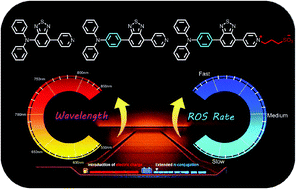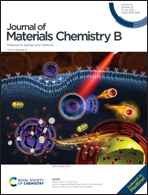Molecular engineering to achieve AIE-active photosensitizers with NIR emission and rapid ROS generation efficiency†
Abstract
Near-infrared (NIR) photosensitizers with rapid reactive oxygen species (ROS) production ability are in great demand owing to their promising performance toward boosting photodynamic therapy (PDT) and deep-tissue imaging, but molecular design guidelines for efficient photosensitizers are rarely elucidated. Herein, three AIEgens named DBP, TBP, and TBP-SO3 are designed and synthesized by precise donor–acceptor (D–A) molecular engineering to deeply understand the structure–property–application relationships. All the compounds exhibit AIE characteristics with strong long-wavelength emission in the aggregated state and are capable of efficiently producing ROS under white light irradiation. By controlling the ability of the D–A units, TBP-SO3 realizes NIR emission and more rapid ROS generation ability due to the promoted intersystem crossing processes compared with those of DBP and TBP. In addition, NIR-emitting TBP-SO3 is capable of specific endoplasmic reticulum targeting and excellent PDT treatment ability of cancer cells and bacteria. This successful example of molecular engineering paves a valuable way for developing advanced PSs with AIE properties, efficient ROS generation ability, and intense emission for fluorescence imaging PDT.



 Please wait while we load your content...
Please wait while we load your content...